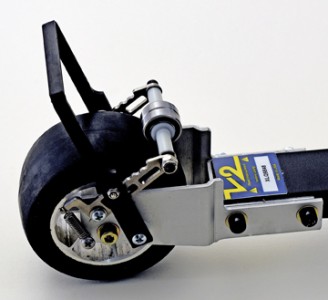Roller Ski Technology

ROLLER SKI TECHNOLOGY (March 2020)
What is fatigue failure? Fatigue failure is the rupture of a material as a result of repeated loading, at a stress much lower than the yield strength of the material, under static conditions. If the stress is high enough, but only a fraction of the yield strength in a static condition, all materials will fail under repeated cycling. Some materials are much more fatigue resistant than others. Even at very low stress, aluminum, copper and brass will fail long before steel and titanium. Because the density of aluminum is very low, airplanes have for a long time been constructed of aluminum. With aluminum’s relatively poor fatigue resistance, aeronautical engineers have to determine the lifespan of the aircraft based on how many times the plane will take off and land and how many hours it will fly. High stress components on aircraft, like wings, are routinely replaced to prevent fatigue failure.
Fatigue studies show that a very smooth surface can dramatically increase the number of cycles before fatigue failure. Fatigue fractures start from areas of localized stress concentration, usually areas with a dent, nick, scratch mark or an invisible manufacturing defect. This is because metals are notch sensitive. Almost all aluminum roller ski shafts that fail are due to bruise or scratch marks on the bottom of the shaft or on the wheel forks where these indentations create high stress areas that cause fatigue crack propagation. When wheel forks are welded to roller ski shafts, the strength of the aluminum of both parts in the welded area is reduced. Failure at the welded joints after repeated cyclic loading is referred to as fatigue weld propagation. A weld that does not create fusion between the two parts is visually apparent and if a load is applied to the weld joint it will fail immediately. The pneumatic wheel roller skis that we produced between 1999 and 2003 used rivets to fasten the wheel forks to the shafts. However, after cyclical stress the rivet joints would loosen. We have been using welded joints on the pneumatic wheel skis for 18 years and they have been very reliable with only a few fatigue crack propagation failures.
Composite fibers like aramid (Kevlar) and carbon bound with epoxy have exceptional fatigue life. The core of the composite is extremely important. After twenty years of trying synthetic and organic cellular cores and a variety of metal cores we are convinced that for roller skis cellular cores are the best.
Snow skis are under very little stress because they bottom out against the snow. Roller skis are under extreme stress as the shaft is supported by wheels only at each end and can’t be flexible because the shaft can’t be permitted to bottom out against the pavement. In order to reduce road vibration there must be some deflection of the shaft, but for aluminum the deflection must be very limited, or the shafts will fatigue very quickly. With more fatigue resistant composite construction like the one used in the V2-XLC, the shafts can be designed to flex more and therefore reduce vibration and feel more like skiing on snow.
MATERIALS BESIDES ALUMINUM USED IN ROLLER SKI SHAFTS
Wood: Wood has quite good fatigue resistance and absorbs vibration quite well. But even the strongest wood materials have a modulus of only 20% that of aluminum, so the shafts have to be thick in order to withstand the load and this makes them heavier. Because of the low modulus, the energy return of wood shafts is low, and the skis are not very responsive compared to composite shaft skis.
Fiber Composites: Our fiber composites have very good fatigue resistance, good vibration damping and are extremely light. But composites structures are very expensive to make. With the poor impact resistance of carbon, it is very important to have a high strength core material. It is also important to combine the unidirectional carbon fibers with more impact resistant fibers, and to protect the unidirectional fibers with a thick and strong biaxial sleeve. That is how the V2-XLC is constructed.
